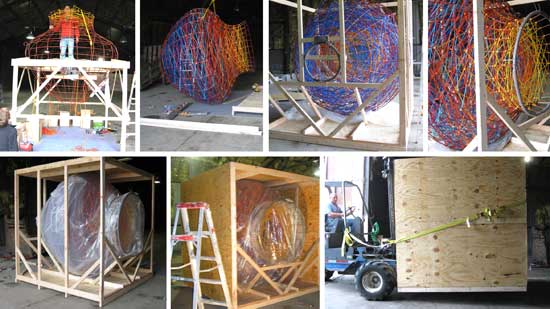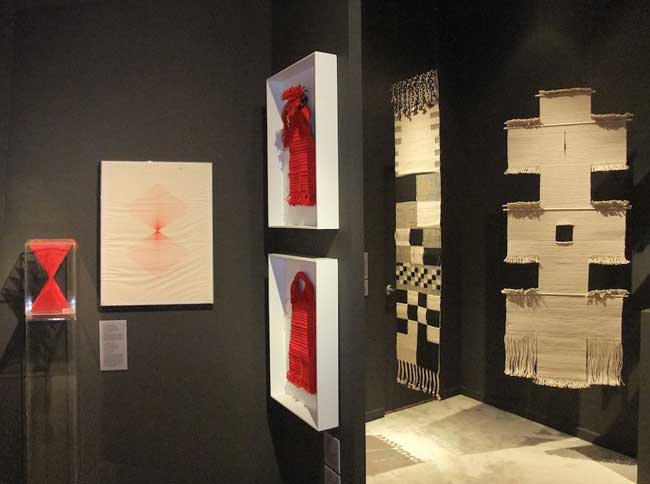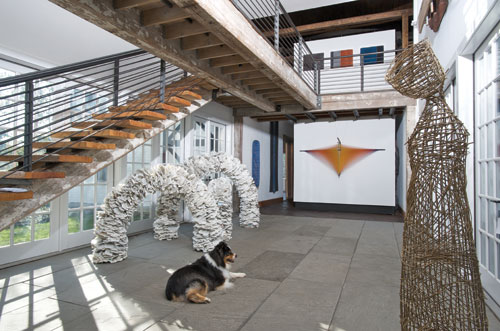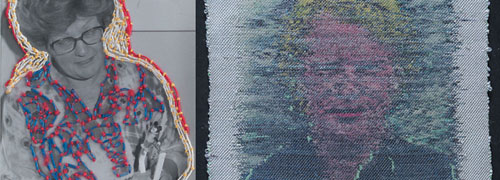browngrotta arts is excited to present the work of sculptor Randy Walker at SOFA West 2010. Walker, who studied architecture, is known for his large-scale commissions using fiber and found objects to explore wrapped and woven three-dimensional space.

Shimmer Frames by Randy Walker
His most recent public artwork, Woven Olla, was unveiled in Santa Fe on June 26th. The City of Santa Fe Arts Commission, in collaboration with the Santa Fe Public Library and New Mexico Arts, a division of the New Mexico Department of Cultural Affairs, commissioned Walker in 2008 to create the three-dimensional, suspended steel and fiber artwork to hang under the main exterior entry canopy of the Southside Branch Library. The sculpture references a traditional Pueblo water jar, or olla, and reinterprets it on a scale appropriate to the community and the Library. Woven Olla marks the entry as a gathering place. The piece is an analogy for the Library as a container of knowledge, a resource no less precious than water.

Construction and shipping of Randy Walker’s “Woven Olla” to Santa Fe
Walker’s work is found in public and private collections around the country, including in Minneapolis, St. Louis and Connecticut. He was a recipient of a Pollock Krasner grant in 2008. In creating his work, the artist seeks out or constructs frameworks that act as looms. These frameworks can be found in objects like saw or they can be architectural spaces. In Saw Piece No. 4 (Autumn), which is featured on the cover of the Summer issue of The Journal of Wealth Management, a salvaged bucksaw creates the armature for a web of nylon thread.
“I am ceaselessly fascinated by the possibilities posed by a single strand of thread held in tension,” Walker explains. “My work straddles precariously on several boundaries: solidity and transparency, structural stability and collapse, visibility and invisibility. I strive to create work that primarily engages our sense of sight by contemplating how light can define structure, surface and color.”
Walker’s dramatic Shimmer Frames, a series of five pieces each 6 feet tall, will grace the entrance at SOFA West 2010.
Technorati Tags: Randy Walker, Santa Fe Public Art, Santa Fe Public Library, Public Art





 We’re leaving the ice and snow (sigh) for sunnier climes next week, where
We’re leaving the ice and snow (sigh) for sunnier climes next week, where 

 Only a few weeks left to left observe the official International Year of Natural Fibres (yes, we’re sticking with the international spelling here). For browngrotta arts and many of the artists we represent, of course, promotion of natural fiber in art and otherwise is a lifelong pursuit. In 2009, however, we had the assistance of the Food and Agriculture Organization of the UN, which declared this year the International Year of Natural Fibres
Only a few weeks left to left observe the official International Year of Natural Fibres (yes, we’re sticking with the international spelling here). For browngrotta arts and many of the artists we represent, of course, promotion of natural fiber in art and otherwise is a lifelong pursuit. In 2009, however, we had the assistance of the Food and Agriculture Organization of the UN, which declared this year the International Year of Natural Fibres






Sneak Peek 10th Wave III Catalog: Essay by Akiko Busch
Writer Akiko Busch has drafted an essay for the catalog 10th Wave III: Art Textiles and Fiber Sculpture, which is being printed this week. Busch is the author of The Uncommon Life of Common Objects (Metropolis Books), Geography of Home: Writings on Where We Live (Princeton Architectural Press) and, most recently, Nine Ways to Cross a River: Midstream Reflections on Swimming and Getting There from Here (Bloomsbury). A former writer for Metropolis Magazine, Busch writes about culture and design for a variety of publications. She is a regular contributor to the Considerings column in American Craft Magazine. About the work in the 10th Wave III, Busch writes,
The 164-page color catalogs can be ordered from http://www.browngrotta.com/Pages/catalog.34.html beginning October 30, 2009.